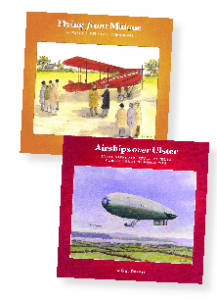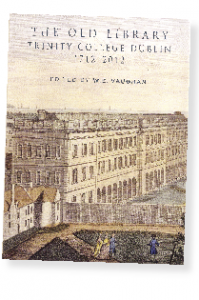Bookworm
Published in Book Reviews, Issue 3 May/June2013, Reviews, Volume 21 Bookworm came across a very interesting book recently: Roger Stalley (ed.), Irish Gothic architecture: construction, decay and reinvention (Wordwell, 230pp, £29.99pb, ISBN 9781905569700). The Gothic style arrived in Ireland in the thirteenth century, being primarily associated with ecclesiastical buildings. Naturally, this multi-authored book begins with the construction of cathedrals, before focusing on the medieval construction and modern reconstruction of Cashel. From there it moves on to look at the impact of the Reformation and conquest, as religious buildings were destroyed or put to other uses, before examining the nineteenth-century ‘Gothic revival’ in Ireland. But the four authors of this coherent and lively volume tackle their subject in a way that sheds light on much more than just buildings, by examining them against the backdrop of the times in which they were built and into which they survived; Cashel, for instance, became a potent nationalist symbol in the nineteenth century. Gothic architecture (or its traces) is still all around us, so this richly illustrated volume is bound to be of interest to a wide audience.
Bookworm came across a very interesting book recently: Roger Stalley (ed.), Irish Gothic architecture: construction, decay and reinvention (Wordwell, 230pp, £29.99pb, ISBN 9781905569700). The Gothic style arrived in Ireland in the thirteenth century, being primarily associated with ecclesiastical buildings. Naturally, this multi-authored book begins with the construction of cathedrals, before focusing on the medieval construction and modern reconstruction of Cashel. From there it moves on to look at the impact of the Reformation and conquest, as religious buildings were destroyed or put to other uses, before examining the nineteenth-century ‘Gothic revival’ in Ireland. But the four authors of this coherent and lively volume tackle their subject in a way that sheds light on much more than just buildings, by examining them against the backdrop of the times in which they were built and into which they survived; Cashel, for instance, became a potent nationalist symbol in the nineteenth century. Gothic architecture (or its traces) is still all around us, so this richly illustrated volume is bound to be of interest to a wide audience.
 Material culture is also at the heart of Fintan O’Toole’s A history of Ireland in 100 objects (Royal Irish Academy, 250pp, £30hb, ISBN 9781908966152). Readers may recall the original series, based on BBC Radio 4’s History of the world in 100 objects, which ran in the Irish Times from January 2011 onwards. This is a novel and beautifully produced journey through Ireland’s past: from a Mesolithic fish-trap to the AK47 by way of the Titanic and the Book of Kells, and much more besides. Given that Thomas O’Loughlin reviews the new facsimile edition of the Book of Kells elsewhere in this issue, mention should be made of a new book about its home: W.E. Vaughan (ed.), The Old Library, Trinity College Dublin, 1712–2012 (Four Courts Press, 480pp, €50hb, ISBN 9781846823770). The foundation stone of Trinity’s magnificent Old Library was laid in May 1712, and this lavish volume ranges over its remarkable contents: from the fifteenth-century Fagel Missal to Napoleonic caricatures, and to what may or may not be Daniel O’Connell’s top hat. Four Courts Press has also published, in association with the Representative Church Body Library, the latest in a series of editions of Church of Ireland manuscripts: Maighréad Ní Mhurchadha (ed.), The Vestry Records of the Parish of St Audoen, Dublin, 1636–1702 (192pp, €55hb, ISBN 9781846823763). The original records were destroyed in the Four Courts in 1922, so this volume is a painstaking reconstruction based on a wide range of copies. The Church of Ireland, being the church ‘as by law established’, had a wide range of civic responsibilities at parish level. St Audoen’s claims to be the oldest surviving church in Dublin, so this is an invaluable resource for the local history of this most central of parishes and the community to which it ministered.
Material culture is also at the heart of Fintan O’Toole’s A history of Ireland in 100 objects (Royal Irish Academy, 250pp, £30hb, ISBN 9781908966152). Readers may recall the original series, based on BBC Radio 4’s History of the world in 100 objects, which ran in the Irish Times from January 2011 onwards. This is a novel and beautifully produced journey through Ireland’s past: from a Mesolithic fish-trap to the AK47 by way of the Titanic and the Book of Kells, and much more besides. Given that Thomas O’Loughlin reviews the new facsimile edition of the Book of Kells elsewhere in this issue, mention should be made of a new book about its home: W.E. Vaughan (ed.), The Old Library, Trinity College Dublin, 1712–2012 (Four Courts Press, 480pp, €50hb, ISBN 9781846823770). The foundation stone of Trinity’s magnificent Old Library was laid in May 1712, and this lavish volume ranges over its remarkable contents: from the fifteenth-century Fagel Missal to Napoleonic caricatures, and to what may or may not be Daniel O’Connell’s top hat. Four Courts Press has also published, in association with the Representative Church Body Library, the latest in a series of editions of Church of Ireland manuscripts: Maighréad Ní Mhurchadha (ed.), The Vestry Records of the Parish of St Audoen, Dublin, 1636–1702 (192pp, €55hb, ISBN 9781846823763). The original records were destroyed in the Four Courts in 1922, so this volume is a painstaking reconstruction based on a wide range of copies. The Church of Ireland, being the church ‘as by law established’, had a wide range of civic responsibilities at parish level. St Audoen’s claims to be the oldest surviving church in Dublin, so this is an invaluable resource for the local history of this most central of parishes and the community to which it ministered.


Speaking of local history, Bookworm recently came across Guy Warner and Ernie Cromie’s Military aviation in Northern Ireland: an illustrated history, 1913 to the present day (Colourpoint, 120pp, £8.99, ISBN 9781780730387). British Army helicopters remain an enduring and controversial image of the ‘Troubles’, and while this lavishly illustrated and fact-filled book covers the more recent conflict, its coverage also extends to both world wars. It is the first in a series that will extend to civil aviation and aircraft-manufacturing in Northern Ireland. Colourpoint has also reissued two related titles by Guy Warner: Airships over Ulster: Royal Air Service airships (64pp, £7.99, ISBN 9781780730080) and Flying from Malone: Belfast’s first civil aerodrome (64pp, £7.99, ISBN 9781780730073). Local history from the other end of the country is represented by Vincent Carmody, Listowel: snapshots of an Irish market town, 1850–1950 (€30, ISBN 9780957461802). It is self-published by the author, but to a standard that puts many established imprints to shame. This is a lavish and beautifully produced account of life in Listowel over the course of a century, organised street by street and adorned with a stunning array of images: photographs, maps, documents, and some wonderful advertisements. This book has obviously been a labour of love and is a model of its kind.



The robust health of local history publishing in Ireland is in marked contrast to the neglect of other fields of inquiry. A notable work that helps to redress the relative dearth of Irish intellectual history in relation to a pivotal era is Tomás Finn’s Tuairim, intellectual debate and policy formation: rethinking Ireland, 1954–1975 (Manchester University Press, 272pp, £65, ISBN 978071908525). Tuarim (‘Opinion’) was a think-tank of sorts, founded against the backdrop of socio-economic crisis in the 1950s and active throughout the transformative decade of the 1960s. With a membership that included Donal Barrington, Garret Fitzgerald and David Thornley, ‘Tuairim’, according to Finn, ‘questioned national myths in a whole range of areas’, and did so quite successfully. It published pamphlets and encouraged debate on a variety of issues: partition and attitudes to Northern Ireland, censorship, education, political reform, the incarceration of children in industrial schools, and a range of other issues that could be seen to exemplify the conservative nature of Irish society. Recent history, and recent revelations about the darker aspects of independent Ireland, seems to confirm the fact that, as Finn suggests, Tuairim was far more significant than it might at first seem.
 Last but not least is the newest issue of Ireland’s most lavish periodical: Seamus Deane and Ciarán Deane (eds), Field Day Review 8: 2012 (Field Day Publications/Keough-Naughton Institute for Irish Studies, University of Notre Dame, 244pp, €35, ISBN 9780946755547). Over half of it is devoted to Roger Casement: Angus Mitchell (whose biography of Casement will be released in the O’Brien Press 16 Lives series) has edited two lengthy, and hitherto unpublished, extracts from Casement’s diaries dealing with his eighteen-month sojourn in Germany. The first details his journey to the German military headquarters on the Western Front in November 1914; the second deals with the final weeks before his fateful return to Ireland on the eve of the Easter Rising. These, and Mitchell’s accompanying essays, will surely be essential reading for anyone interested in this period. HI
Last but not least is the newest issue of Ireland’s most lavish periodical: Seamus Deane and Ciarán Deane (eds), Field Day Review 8: 2012 (Field Day Publications/Keough-Naughton Institute for Irish Studies, University of Notre Dame, 244pp, €35, ISBN 9780946755547). Over half of it is devoted to Roger Casement: Angus Mitchell (whose biography of Casement will be released in the O’Brien Press 16 Lives series) has edited two lengthy, and hitherto unpublished, extracts from Casement’s diaries dealing with his eighteen-month sojourn in Germany. The first details his journey to the German military headquarters on the Western Front in November 1914; the second deals with the final weeks before his fateful return to Ireland on the eve of the Easter Rising. These, and Mitchell’s accompanying essays, will surely be essential reading for anyone interested in this period. HI
















